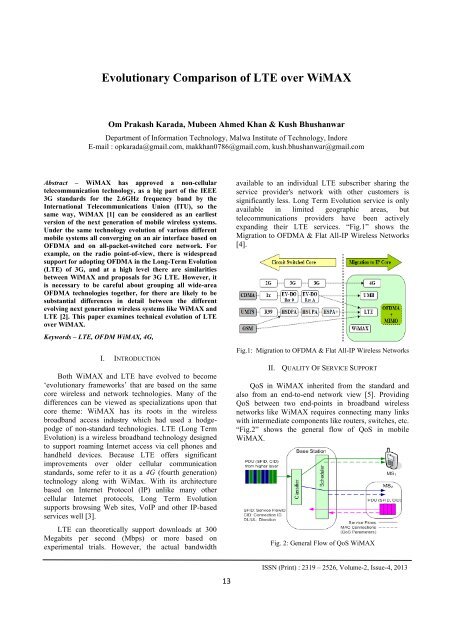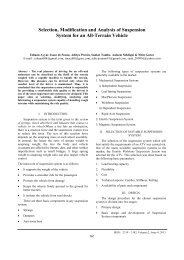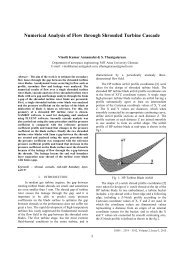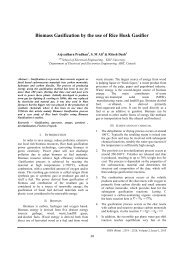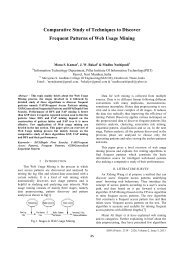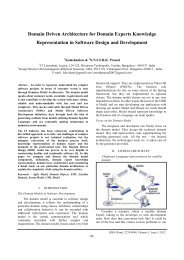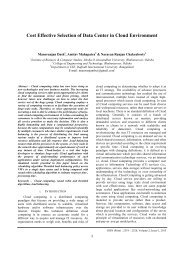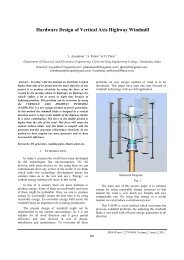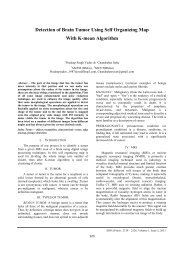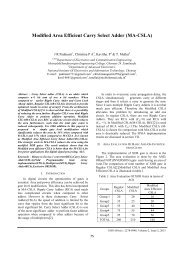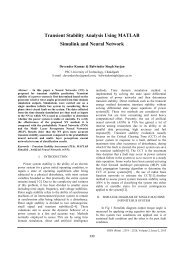Evolutionary Comparison of LTE over WiMAX - IRD India
Evolutionary Comparison of LTE over WiMAX - IRD India
Evolutionary Comparison of LTE over WiMAX - IRD India
Create successful ePaper yourself
Turn your PDF publications into a flip-book with our unique Google optimized e-Paper software.
<strong>Evolutionary</strong> <strong>Comparison</strong> <strong>of</strong> <strong>LTE</strong> <strong>over</strong> <strong>WiMAX</strong>Om Prakash Karada, Mubeen Ahmed Khan & Kush BhushanwarDepartment <strong>of</strong> Information Technology, Malwa Institute <strong>of</strong> Technology, IndoreE-mail : opkarada@gmail.com, makkhan0786@gmail.com, kush.bhushanwar@gmail.comAbstract – <strong>WiMAX</strong> has approved a non-cellulartelecommunication technology, as a big part <strong>of</strong> the IEEE3G standards for the 2.6GHz frequency band by theInternational Telecommunications Union (ITU), so thesame way, <strong>WiMAX</strong> [1] can be considered as an earliestversion <strong>of</strong> the next generation <strong>of</strong> mobile wireless systems.Under the same technology evolution <strong>of</strong> various differentmobile systems all converging on an air interface based onOFDMA and on all-packet-switched core network. Forexample, on the radio point-<strong>of</strong>-view, there is widespreadsupport for adopting OFDMA in the Long-Term Evolution(<strong>LTE</strong>) <strong>of</strong> 3G, and at a high level there are similaritiesbetween <strong>WiMAX</strong> and proposals for 3G <strong>LTE</strong>. However, itis necessary to be careful about grouping all wide-areaOFDMA technologies together, for there are likely to besubstantial differences in detail between the differentevolving next generation wireless systems like <strong>WiMAX</strong> and<strong>LTE</strong> [2]. This paper examines technical evolution <strong>of</strong> <strong>LTE</strong><strong>over</strong> <strong>WiMAX</strong>.Keywords – <strong>LTE</strong>, OFDM <strong>WiMAX</strong>, 4G,I. INTRODUCTIONBoth <strong>WiMAX</strong> and <strong>LTE</strong> have evolved to become‗evolutionary frameworks‘ that are based on the samecore wireless and network technologies. Many <strong>of</strong> thedifferences can be viewed as specializations upon thatcore theme: <strong>WiMAX</strong> has its roots in the wirelessbroadband access industry which had used a hodgepodge<strong>of</strong> non-standard technologies. <strong>LTE</strong> (Long TermEvolution) is a wireless broadband technology designedto support roaming Internet access via cell phones andhandheld devices. Because <strong>LTE</strong> <strong>of</strong>fers significantimprovements <strong>over</strong> older cellular communicationstandards, some refer to it as a 4G (fourth generation)technology along with WiMax. With its architecturebased on Internet Protocol (IP) unlike many othercellular Internet protocols, Long Term Evolutionsupports browsing Web sites, VoIP and other IP-basedservices well [3].<strong>LTE</strong> can theoretically support downloads at 300Megabits per second (Mbps) or more based onexperimental trials. However, the actual bandwidthavailable to an individual <strong>LTE</strong> subscriber sharing theservice provider's network with other customers issignificantly less. Long Term Evolution service is onlyavailable in limited geographic areas, buttelecommunications providers have been activelyexpanding their <strong>LTE</strong> services. ―Fig.1‖ shows theMigration to OFDMA & Flat All-IP Wireless Networks[4].Fig.1: Migration to OFDMA & Flat All-IP Wireless NetworksII. QUALITY OF SERVICE SUPPORTQoS in <strong>WiMAX</strong> inherited from the standard andalso from an end-to-end network view [5]. ProvidingQoS between two end-points in broadband wirelessnetworks like <strong>WiMAX</strong> requires connecting many linkswith intermediate components like routers, switches, etc.―Fig.2‖ shows the general flow <strong>of</strong> QoS in mobile<strong>WiMAX</strong>.Fig. 2: General Flow <strong>of</strong> QoS <strong>WiMAX</strong>13ISSN (Print) : 2319 – 2526, Volume-2, Issue-4, 2013
International Journal on Advanced Computer Theory and Engineering (IJACTE)Since <strong>WiMAX</strong> is envisioned to provide end-to-endIP services and will likely be deployed using an IP corenetwork, IP QoS and its interaction with the wirelesslink layer are what is most relevant to <strong>WiMAX</strong> networkperformance. The QoS provided by a network is aperformance level indicator, typically specified in terms<strong>of</strong> throughput, packet loss, delay, and jitter, and therequirements vary, based on the application and service.There are more components and functionalities in anend-to-end network providing QoS than the air interfaceQoS features discussed above, such as policy controland charging (PCC) functions in QoS provisioning.―Fig.3‖ shows the general flow <strong>of</strong> QoS in <strong>LTE</strong>. Weshow the comparison <strong>of</strong> the QoS framework between<strong>LTE</strong> and IEEE 802.16e/IEEE 802.16m at the airinterface [6]:• QoS transport unit: The basic QoS transport unit inthe IEEE 802.16e/IEEE 802.16m system is an SF, whichis a unidirectional flow <strong>of</strong> packets either UL from theMS/AMS or DL packets from the BS/ABS [7]. Thebasic QoS transport in <strong>LTE</strong> is a bearer between UE andthe PDNGW. All packets mapped to the same bearerreceive the same treatment.• QoS scheduling types: There are six schedulingservice types in IEEE 802.16m including UGS, ertPS,rtPS, nrtPS, and BE from IEEE 802.16e and the newlydefined aGP service. <strong>LTE</strong> supports GBR and non-GBRbearers. The GBR bearer will be provided by thenetwork with a guaranteed service rate, and itsmechanism is like rtPS; the non-GBR has no suchrequirement and performs like BE in IEEE802.16e/IEEE 802.16m [7].• QoS parameters per transport unit: Depending onthe SF type, IEEE 802.16e/ IEEE 802.16m can controlmaximum packet delay and jitter, maximum sustainedtraffic rate (MSTR), minimum reserved traffic rate(MRTR), and traffic priority. <strong>LTE</strong> MBR and GBR aresimilar to IEEE 802.16e/IEEE 802.16m MSTR andMRTR, respectively. However, MBR and GBR are onlyattributes <strong>of</strong> GBR bearers, while in IEEE 802.16e/IEEE802.16m even a BE SF can be rate limited using itsMSTR. Also, with 3GPP Release 8, GBR and MBR areset equal, while IEEE 802.16e/IEEE 802.16m allows theoperator to select independent values for MSTR andMRTR. On the other hand, <strong>LTE</strong> AMBR allows theoperator to rate cap the total non-GBR bearers <strong>of</strong> asubscriber [7].• QoS handling in the control plane: The SF QoSparameters are signaled in IEEE 802.16e/IEEE 802.16mvia DSx/AAI-DSx messages. In <strong>LTE</strong> the QCI andassociated nine standardized characteristics are notsignaled on any interface. Network initiated or clientinitiated QoS are both supported in IEEE 802.16e/IEEE802.16m systems. Therefore, both operator managedservice and unmanaged service can be supported. Theflexible architecture gives the mobile clientopportunities for differentiation. <strong>LTE</strong> only supportsnetwork initiated QoS control [7].• QoS user plane treatment: The ARP parameter in<strong>LTE</strong> provides the following flexibilities to the operator:–Accept or reject establishment or modification <strong>of</strong>bearers during the call admission control decision basedon not only the requested bandwidth, availablebandwidth, or number <strong>of</strong> established bearers, but alsothe priority <strong>of</strong> the bearer –Selectively tear down bearersbased on their priorities during an <strong>over</strong>load situation [7].Fig.3: General Flow <strong>of</strong> QoS in <strong>LTE</strong>III. <strong>LTE</strong> VS WIMAXThe primary difference between <strong>LTE</strong> and <strong>WiMAX</strong>are the differences in upbringing: like close cousins,there are deep blood ties between the two standards,(similar frameworks <strong>of</strong> technology), but the ‗families‘that have raised them are different: different goals anddifferent means. But as each group has now preparedtheir standards to fulfill proposal requirements mandatedby ITU, International Telecommunications Union, IMT-Advanced, the two standards are seeking jobs at thesame huge ‗factory‘ – the factory <strong>of</strong> open IP unifiedcommunications [8].So, when the discussion is about ‗What is <strong>WiMAX</strong>(or <strong>LTE</strong>)‘ the answer should also include a statementthat ―these are two systems developing along the samelines but optimized to work somewhat differently.<strong>WiMAX</strong> is primarily aimed at Greenfield (new) fixed tomobile deployments while <strong>LTE</strong> is mostly aimed atincumbent (existing) deployments that must work withexisting networks and business practices‖ as shown in―Fig.4‖ [9].But you can quickly see even that is a simplificationthat does not completely fit the current state <strong>of</strong>development: Sprint now sells dongles with mobiledevices soon to appear that will support both Clearwire‘s <strong>WiMAX</strong> and Sprint‘s 3G EVDO [10] – [11]. Andthey are working on doing seamless hand-<strong>of</strong>fs <strong>of</strong> voice14ISSN (Print) : 2319 – 2526, Volume-2, Issue-4, 2013
International Journal on Advanced Computer Theory and Engineering (IJACTE)and other communications. That will soon mean users <strong>of</strong>Google Android or other phones and mobile deviceswill be able to start a VoIP call on the <strong>WiMAX</strong> networkand keep on talking as they travel to a Sprint orcollaborating 3G network. Chips are in the works to alsoallow that to happen across <strong>WiMAX</strong> and HSPA/GSM.Likewise, some <strong>LTE</strong> developers say it will be used forfixed networks as well as for mobile networks.Fig.4: Potential Deployment <strong>of</strong> WiMax & <strong>LTE</strong>The next versions <strong>of</strong> both, 802.16m <strong>WiMAX</strong>m and<strong>LTE</strong>-Advanced [12], are being designed to meet thesame guidelines for IMT-Advanced which calls for anadaptive framework that can be used from local areafixed networks to large scale mobile networks and to usemultiple carriers across multiple bands <strong>of</strong> spectrum.―Fig.5‖ shows that, how latency in decreased andcapacity in increased <strong>over</strong> the year for <strong>LTE</strong>.Fig.5: Performance <strong>of</strong> <strong>LTE</strong> Over the YearThe 4G <strong>LTE</strong> network is only available in 38 citiesin the USA, c<strong>over</strong>ing about 35% <strong>of</strong> the current Verizonsubscribers. The company is quickly building moretowers across the country, but it will not be nationwideuntil 2013.Carriers can choose to deploy <strong>LTE</strong> networks eitherin FDD (frequency division duplex) or TDD (timedivision duplex) versions. Since WiMax is a TDtechnology and shares more assets with the latter, TD-<strong>LTE</strong> presents a more efficient migration option forWiMax operators. Those with broad spectrum rightssuch as Clear wire in the US have the option <strong>of</strong> dividingup that spectrum between WiMax and TD-<strong>LTE</strong> so thatthey can enter the <strong>LTE</strong> market without cutting <strong>of</strong>f theirexisting subscriber base. .There are upcoming spectrum auctions for 2.3 GHzand 2.5 GHz spectrum bands that is better suited forTDD. Operators so far found little interest in the TDDband and WiMax had positioned itself very well for theTDD band. Operators are in general opposed to theWiMax roll out as it encourages open ecosystem andmore<strong>over</strong> was an entirely different technology with noevolutionary path from either GSM or CDMA. <strong>WiMAX</strong>is controlled by IEEE, the consumer electronicsindustry, which is far more open than telecom/3GGP.However, now operators see a clear synergy in rollingout TD-<strong>LTE</strong> networks if the TDD spectrum comes upfor auction. In <strong>India</strong>, the operators may actually bebidding for BWA to roll-out TD-<strong>LTE</strong> rather thanWiMax. [13] – [14].IV. CONCLUSIONMobile <strong>WiMAX</strong> is superior to <strong>LTE</strong> in terms <strong>of</strong>security aspects in mobile enterprise networks. Also thedeployment speed and the low costs are advantages forMobile <strong>WiMAX</strong>. In addition, it is more power-efficientin the <strong>over</strong>all power consumption. More<strong>over</strong>, the currentdeployment and c<strong>over</strong>age <strong>of</strong> Mobile <strong>WiMAX</strong> is muchhigher. However, the <strong>LTE</strong> deployment recently startedand more and more operators choose the <strong>LTE</strong>/SAEarchitecture for their future wireless telecommunicationnetwork. The main reason for this is that the majority <strong>of</strong>operators uses 3GPP GSM or UMTS networks andparticipates, within the 3GPP, in the development <strong>of</strong>future 3GPP networks [15]. <strong>LTE</strong>-Advanced andWireless MAN-Advanced provide future extensions tothe current approaches. Therefore both technologies areassured <strong>of</strong> a good future. The competition scenarios arediverse and depend on the deployment region. <strong>LTE</strong>dominates the Western European market, whereasMobile <strong>WiMAX</strong> is the only 4G technology in <strong>India</strong>. Inconclusion, as in the previous generations <strong>of</strong>telecommunication networks there will be a global coexistence<strong>of</strong> <strong>LTE</strong> and Mobile <strong>WiMAX</strong> and their futuredevelopments. We also presented the mapping <strong>of</strong> QoSparameters between <strong>WiMAX</strong> and <strong>LTE</strong> to provideassured QoS to the end users .As per the comparisonchart it is imperative that both Mobile <strong>WiMAX</strong> and <strong>LTE</strong>have merits <strong>over</strong> the other and hence both Mobile<strong>WiMAX</strong> and <strong>LTE</strong> technologies can co-exist with eachother.15ISSN (Print) : 2319 – 2526, Volume-2, Issue-4, 2013
International Journal on Advanced Computer Theory and Engineering (IJACTE)While 100 million global <strong>LTE</strong> users is aconsiderable on increase on a figure that was 30 milliontwelve months ago, it is assumed that <strong>LTE</strong> adoptionrocketing past 300 million by 2014. ―Fig.6‖ shows thesubscriber forecasting for 4G <strong>over</strong> the world. This workcan be used to prioritize future research directions inWiMax/802.16e and <strong>LTE</strong>.Fig.6: Worldwide Subscriber Forecast <strong>of</strong> <strong>WiMAX</strong> & <strong>LTE</strong>V. REFERENCES[1] "<strong>WiMAX</strong> and the IEEE 802.16m Air InterfaceStandard". WiMax Forum. 4 April 2010. Retrieved2012-02-07.[2] J. M. Andreas Mitschele-Thiel, ―3G Long-termEvolution (<strong>LTE</strong>) and System Architecture Evolution(SAE),‖ University Lecture, 2009.[3] H. Holma and A. Toskala, <strong>LTE</strong> for UMTS - Evolutionto <strong>LTE</strong>-Advanced, second edition ed. John Wiley andSons Ltd., 2011.[4] <strong>WiMAX</strong> Forum – <strong>WiMAX</strong> Home,http://www.wimaxforum.org, 2008.[5] <strong>WiMAX</strong> and End-to-End QoS Support MohammadAbdul Awal and Lila Boukhatem Univ. <strong>of</strong> Paris-Sud11,CNRSBat490,91405OrsayCedex.Availableat:http://www.lri.fr/~awal/publication/wimax_e2e_qos_iste.pdf[6] Quality <strong>of</strong> Service in <strong>WiMAX</strong> and <strong>LTE</strong> Networks.Mehdi Alasti and Behnam Neekzad, Clearwire JieHui and Rath Vannithamby, Intel Labs IEEECommunications Magazine May 2010[7] IEEE 802.16m/D4, ―Draft Amendment to IEEEStandard for Local and Metropolitan Area Networks— Part 16: Air Interface for Fixed and MobileBroadband Wireless Access Systems, Advanced AirInterface,‖ Feb. 2010.[8] L. Yi, K. Miao, and A. Liu, ―A Comparative Study <strong>of</strong><strong>WiMAX</strong> and <strong>LTE</strong> as the Next Generation MobileEnterprise Network,‖ in Advanced CommunicationTechnology (ICACT)[9] V. Marques, R. L. Aguiar, C. Garcia, J. I. Moreno, C.Beaujean, E. Melin, M.Liebsch, ―An IP-based QoSarchitecture for 4G operator scenarios‖, IEEE WirelessCommunications, vol. 10, pp. 54-62, 2003.[10] IEEE 802.1p: LAN Layer 2 QoS/CoS Protocol forTrafficPrioritization,http://www.javvin.com/protocol8021P.html, 2008.[11] <strong>WiMAX</strong> Forum White Paper, ―Mobile <strong>WiMAX</strong> - Part1: A Technical Overview and PerformanceEvaluation‖, <strong>WiMAX</strong> Forum, June 2006.[12] <strong>WiMAX</strong> Forum Network Working Group WhitePaper, ―<strong>WiMAX</strong> End-to-End Network SystemsArchitecture, (Stage 2: Architecture Tenets, ReferenceModel and Reference Points)‖, <strong>WiMAX</strong> Forum, March2006.[13] http://www.telecomcircle.com/2009/09/what-is-thedifferedif-between-wimax-and-lte[14] http://www.telecomcircle.com/2010/06/td-lte-the-nextfronfron[15] http://www.dailywireless.org/2012/04/03/india-hspakkki-by-2016.16ISSN (Print) : 2319 – 2526, Volume-2, Issue-4, 2013


